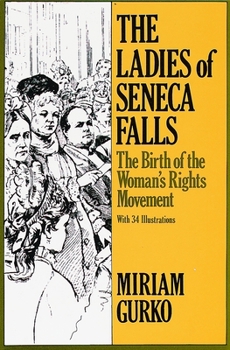The Ladies of Seneca Falls: The Ladies of Seneca Falls: The Birth of the Woman's Rights Movement
Select Format
Select Condition 
Book Overview
On July 13, 1848, five women conversed over tea in a small upstate New York town. The next day, the local newspaper carried their announcement inviting women to attend "A Convention to discuss the social, civil, and religious condition and rights of women.″ A few days later, the American woman's right movement became reality. Miriam Gurko traces the course of the movement from its origin in the Seneca Falls Convention through the passage of the Nineteenth Amendment giving women the right to vote. She examines each of the movement's founders--Elizabeth Cady Stanton, Lucretia Mott, Susan B. Anthony, Lucy Stone, and others--to show the various backgrounds from which their feminist consciousness sprang and the unique contribution that each made to the destiny of the movement. This straightforward, comprehensive history of the early years of the woman's rights movement in America is essential background reading for anyone involved with women's studies. With 34 black-and-white illustrations
Format:Paperback
Language:English
ISBN:0805205454
ISBN13:9780805205459
Release Date:December 1987
Publisher:Knopf Publishing Group
Length:352 Pages
Weight:0.80 lbs.
Dimensions:1.1" x 5.3" x 8.1"
Customer Reviews
4 ratings
The Long Arduous Struggle For A Woman's Right To Vote
Published by Thriftbooks.com User , 16 years ago
March Is Woman's History Month One of the few historically interesting anecdotes that came our of last year's Democratic Party nomination process during the America presidential election campaign that pitted both the first serious black, Barack Obama, and woman, Hillary Clinton, candidates for that office was the rounding up of a number of very elderly women who were the beneficiaries of the successful struggle for the woman's right to vote by the Clinton campaign to be used as symbol of the need to go that next step and elect a woman president. The historic symbolism of those gestures brought into sharp relief the very long, arduous struggling for the right of women to vote. Equally, it brought into relief the sometimes frictional nature of the two constituencies represented by the two campaigns last year in those earlier days of struggle for increasing the democratic franchise beyond that of then narrow one of white male property owners and their hangers-on. That tension is the subject, or rather one of the subjects, of this very readable narrative history of the movement that uses the organizing efforts culminating in the famous Seneca Falls Woman's Right Convention in 1848 as its central focus. Moreover, today at a time when there is something of a lull in the current "third wave" women's movement about where it should head and what issues it should fight around a quick read of the past, its struggles, its controversies and its victories seems in order as we commemorate Woman' History Month. A number of books that I review, and the present volume is one such example, concerning important issues for political leftists are older ones. I again provide the caveat that this book is a place to begin and reflects the knowledge and understandings of thirty years ago in the heat of the "second wave" women's movement. It is nevertheless a place to start. It may seem unbelievable today, and probably even the most hidebound male chauvinist, that in the early part of the 19th century here is the democratic citadel of America that not only were the overwhelming majority of blacks disenfranchised but that was also the case with women. The well-known plight of most blacks as slaves, male and female, reduced them to chattel property with no rights that "a white man need respect." What is not so well-known is that as to property rights, access to the courts, education and most conditions of life the women of America had no rights that "a white male need respect". The struggle to turn this condition of servitude around is quite well detailed in Ms. Gurko's study. In the early 19th century the role of women in politics, if any, was as an adjunct to men's interests. This was a period, particularly in the "Age of Jackson" when there were a plethora of reform movements led by men. Women centrally concerned themselves with the religious revival, temperance or anti-slavery agitation. The question of women's rights, as it emerged and became a separate
Ladies of Seneca Falls
Published by Thriftbooks.com User , 18 years ago
This was an excellent historical account of the early phase of the women's rights movement It provides the background of several of the woman viewed as leaders of the women's movement. It provides a perspective and offers details which other accounts fail to provide. The struggles of the women who were at the forefront of the women's movement in its early years is lucidly presented. It is a well written account and added substantially to my knowledge of the early phases of the movement. I highly recommend the book.
Great read; great reminder
Published by Thriftbooks.com User , 20 years ago
Our (usually fiction-reading) book club read this in October, 2004. I avoided starting it for a long time, but as soon as I got past the first chapter, I couldn't put it down. It was amazingly well-written with wonderful stories of the women who only earned a passing mention in our 7th-grade history books. This book made me see how many dedicated and strong women were needed to make a basic change in American culture and made each member appreciate her right to vote so much more in the November 2004 election.
An essential reference
Published by Thriftbooks.com User , 26 years ago
A thorough, easily-read, fascinating book about the early American Women's Rights movement. I have read many books on this subject, and rate this as one of the highest in objectivity and appeal. Especially good as a springboard for those not already familar with the subject. Brush up on your HERstory!





